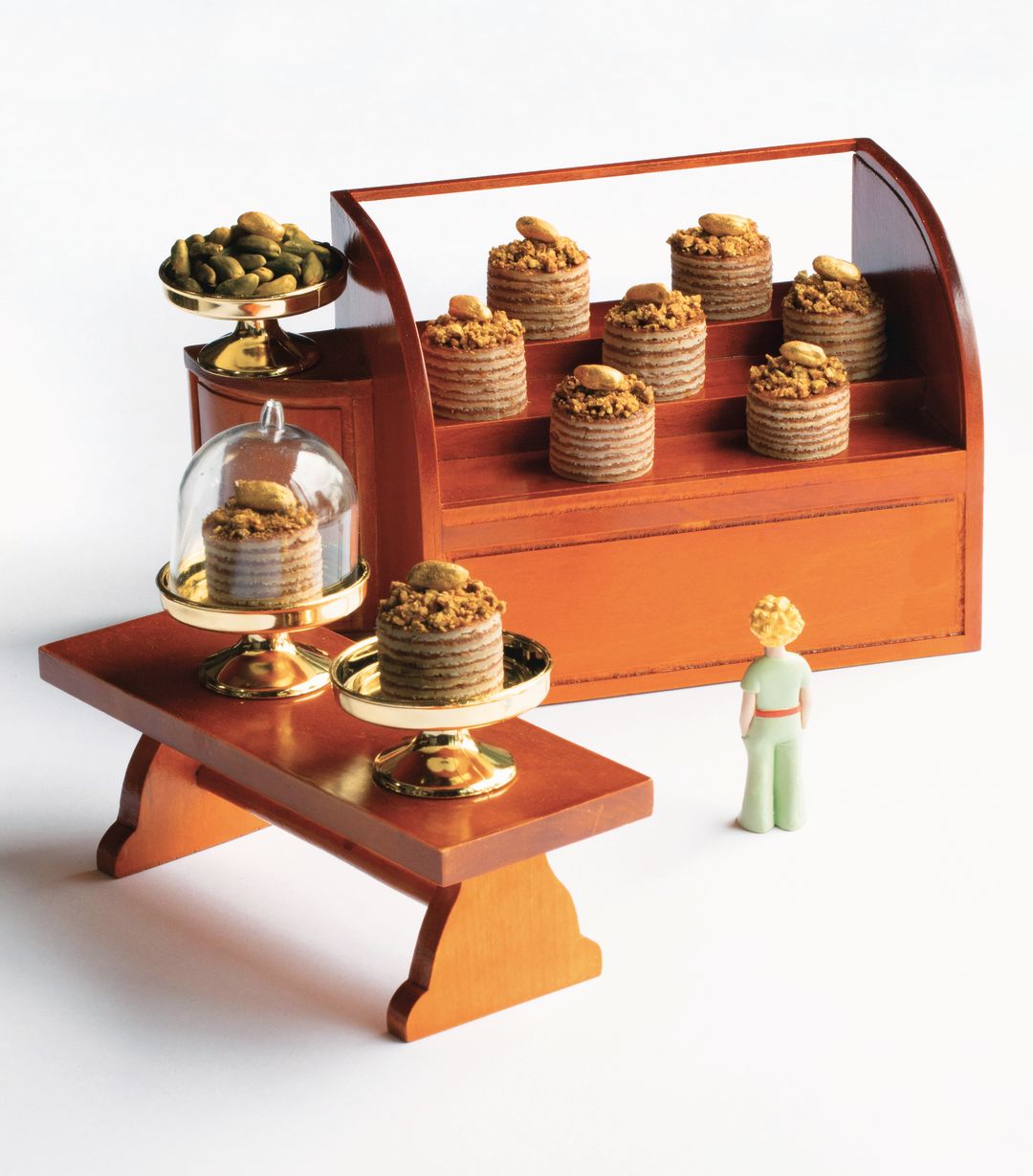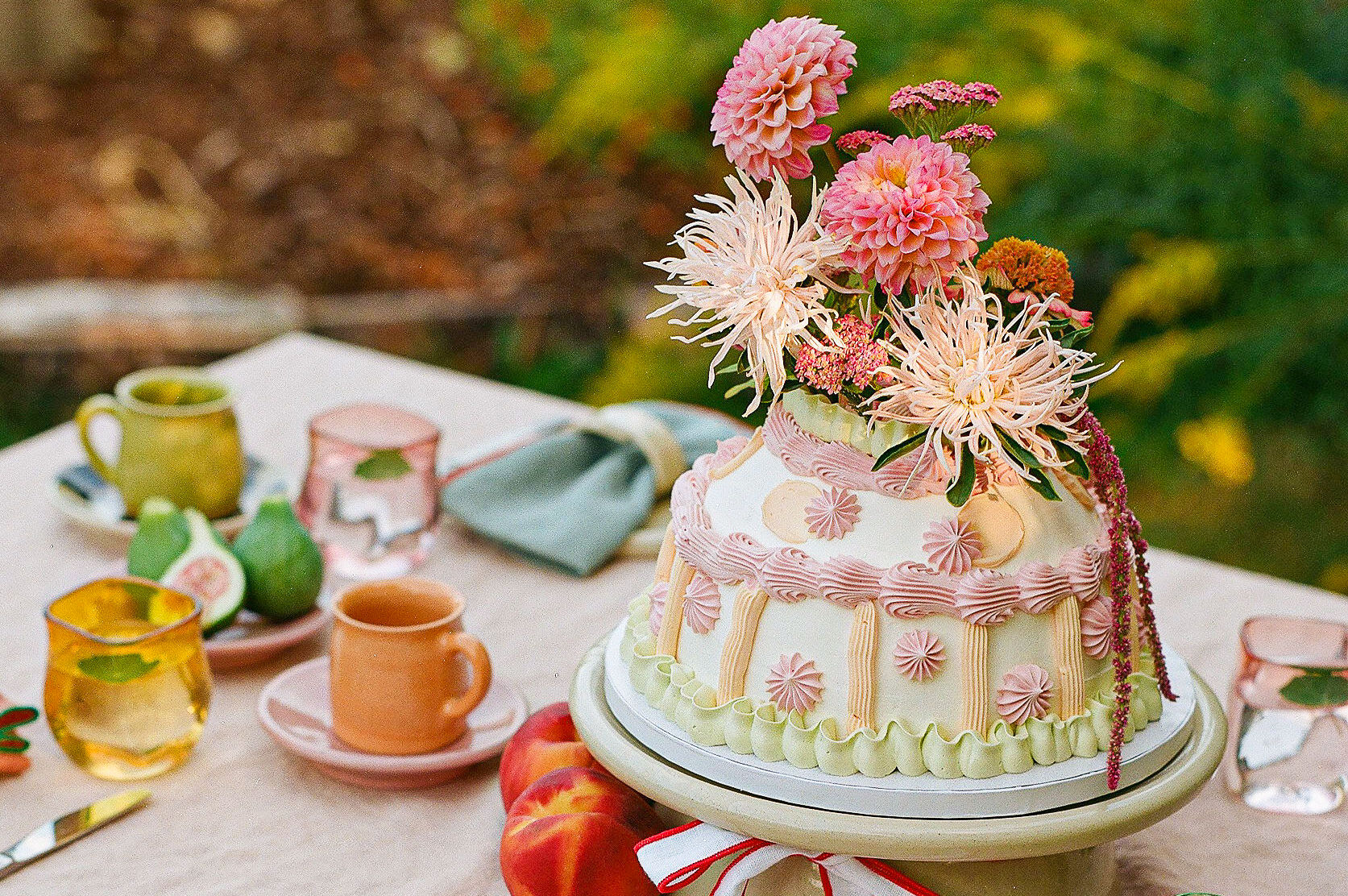Pix Pâtisserie Chef Releases New Cookbook

Try your hand at making the 7-Layer "Cakes" from Cheryl Wakerhauser's new cookbook, Petite Pâtisserie.
Image: Courtesy Alan Weiner
Bored of baking sourdough loaves and banana bread? Cheryl Wakerhauser, pastry chef and owner of Pix Pâtisserie, launched her second cookbook on August 25, entitled Petite Pâtisserie: Bon Bons, Petits Fours, Macarons and Other Bite-Size Treats, complete with a Pix-O-Matic release party.
Though you can order the book online, locals can also call Pix Pâtisserie to order a copy signed by Wakerhauser. And, from now until August 31, Portlanders can also stop by the 24-hour pastry vending machine, the Pix-O-Matic, to pick up petits fours featured in the book, molds for baking petits fours (including the adorable strawberry ones on the cover), and other tools and ingredients you’ll need for the book’s recipes.
This cookbook focuses on all things miniature—bon bons, cookies, savory bites, sippable shot desserts, and petits fours—and aims to expand your idea of what a petit four can be.
“A lot of people pronounce it ‘petty fours’ ... there’s nothing petty about them!” Wakerhauser says. “A lot of people think of a petit four as a square, white fondant-covered layer cake.”
“But really, the word just means little ovens,” she adds. “It could be anything, it could look like anything, it could taste like anything. It can be savory, too. Anything you can have in two or three bites.”
The cookbook aims to please home bakers as well as professional pastry chefs. “I tried to make it more approachable for a home baker that’s not as experienced,” Wakerhauser says, including by sharing some surprisingly easy baking techniques. Turns out, you can use the microwave to melt chocolate—and since it doesn’t produce any steam, Wakerhauser believes it actually works better than a bain marie. Tip No. 2: Use the freezer to set macaron shells after baking, and to keep pastries fresh until ready to serve.
The easiest recipe, Wakerhauser says, is probably the no-baking-or-tempering-involved chocolate hazelnut bon bons she calls Gold Nuggets. On the opposite side of the spectrum, perfect for whiling away a whole day of home quarantine, are more demanding recipes like the Provence, which combines tarragon meringue, sweet tart dough, craquelin, pate a choux, and lemon cream into two-bite versions of the fanciest lemon tart you’ve ever tasted.
One of the book’s easiest petit four recipes is the 7-Layer “Cake”: miniature no-bake crêpe cakes soaked in Grand Marnier, layered with chocolate pastry cream and topped with candied pistachios. Try your hand at making them yourself:
7-Layer Cake
Birthday cakes for French Chihuahuas.
Crêpes are easy to make and can be filled with a variety of things. Instead of filling our crêpes, we will layer them, over and over, with chocolate pastry cream and spike them with orange liqueur. Cut circles out of them with a round pastry cutter and you have mini layer cakes!
For this recipe you will need a 3-centimeter (1.2-in) round pastry cutter that is at least the same height as its diameter and a nonstick skillet measuring 20 centimeters (8 in) on the bottom. If you do not have a nonstick skillet, it is recommended to rub the pan with a stick of butter before cooking each crêpe, and note the cooking time in the pan may vary.
YIELD: 24 MINI LAYER CAKES
CRÊPES
250 g whole milk
3 g orange zest, finely zested with a microplane
37 g unsalted butter, room temperature
75 g eggs
125 g pastry flour
20 g granulated sugar
2 g salt
20 g Cointreau or Grand Marnier orange liqueur
CHOCOLATE PASTRY CREAM
190 g whole milk
40 g egg yolks
50 g granulated sugar
15 g cornstarch
12 g unsalted butter, room temperature
85 g dark chocolate, coarsely chopped
CARAMELIZED PISTACHIOS
50 g pistachios
50 g granulated sugar
12 g water
CRÊPES
In a small saucepan, bring the milk and orange zest to a simmer. Remove from the heat, add the butter, and stir until melted. Pour the mixture into a small, narrow container such as a 1-liter (1-qt) plastic deli container or liquid measuring cup. Add the eggs, pastry flour, sugar, salt, and orange liqueur and blend with an immersion blender until combined. Refrigerate the batter for at least 1 1⁄2 hours, up to a maximum of 2 days.
Blend the cold batter with an immersion blender for 10 seconds to make it more fluid and easier to work with. Place two half sheet pans lined with parchment paper next to the stove.
Heat a 20-centimeter (8-in) nonstick skillet over medium heat until hot, about 11⁄2 minutes. Pour 65 grams of the batter directly into the center of the skillet. Immediately tilt the skillet and let the batter come just to the edge of the flat surface, before turning it in a circular motion to coat the entire bottom of the skillet without going up the sides. Cook until the top of the crêpe is barely wet and the edges are just starting to brown, about 10 seconds. Use a rubber spatula to lift up the edge and use your fingers to flip it over. Continue to cook the other side until set and you are able to lift the crêpe out of the pan, about another 10 seconds. Your first side will always be browner than the second because the pan heats up between crêpes. Transfer the crêpe to the sheet pan to cool. Continue to cook until you have 7 crêpes. If one doesn’t work out well (usually the first!) you should have enough batter to make 1 extra crêpe. Spread the crêpes over the sheet pans as you go, even hanging over the edge of the pans, to cool completely. Stack the cooled crêpes with parchment paper in between each one. If not using immediately, wrap the stack in plastic wrap, and store in the refrigerator.
CHOCOLATE PASTRY CREAM
Prepare a pastry cream in the microwave: Place the milk, egg yolks, sugar, cornstarch, and butter into a 1-liter (1-qt) plastic deli container or other narrow container of similar size, such as a liquid measuring cup. Blend the ingredients with an immersion blender (it is fine if the butter remains in chunks) and then place the container in the microwave. Cook on high until the pastry cream looks curdled on top and jiggles when you shake the container, about 2 minutes. (If you are using a glass container, check the cream at 1 1/2 minutes.) Blend the cream again with the immersion blender until smooth, making sure to scrape the sides and bottom of the container as you mix. The hot pastry cream will have the consistency of a thick soup and coat the back of a spoon. If it does not, place it back in the microwave for 30 more seconds and blend again. The pastry cream will continue to thicken as it cools. Stir in the chocolate and let it sit for 1 minute to melt before blending again. Place a piece of plastic wrap directly on the surface of the cream and refrigerate.
CARAMELIZED PISTACHIOS
Line a half sheet pan with a silicone baking mat.
Chop the pistachios by hand into tiny pieces, slightly smaller than the size of a lentil.
In a small saucepan, combine the sugar and water over medium heat. Heat the sugar until it reaches 240°F (116°C). Add the pistachio pieces and stir with a wooden spoon to coat. Continue to cook over medium heat, slowly stirring. The sugar will seize up and crystallize. When that happens, remove the saucepan from the heat and break up the pistachio pieces with the spoon. Return to the heat, stirring constantly. The sugar will melt and then start to caramelize. The pieces will begin to look brown, but that is the caramel forming, not the nuts burning. Once the nuts are fragrant and covered in a deep brown caramel, remove from the heat and pour the nuts onto the silicone mat. Spread out into a single layer and allow to cool.
Transfer the cold pastry cream to a bowl of a stand mixer fitted with the paddle attachment. Mix on medium-high until smooth, about 30 seconds.
Place 1 crêpe on a half sheet pan lined with parchment paper. Spread 40 grams of pastry cream evenly over the entire surface of the crêpe. Top with a second crêpe and spread another 40 grams of cream over the surface. Continue to layer until you have 6 layers of cream and 7 layers of crêpes. Spread a thinner layer of 25 grams of pastry cream over the top. Place the layered crêpes in the freezer to freeze completely. If the center is not initially frozen, the layers will not cut as evenly.
Remove the crêpes from the freezer and allow them to soften just enough so you can barely cut through them with a pastry cutter, about 20 minutes at room temperature. Using a 3-centimeter (1.2-in) round pastry cutter of at least the same height, cut a circle out of the crêpe layer cake, pushing the cutter all the way through the bottom crêpe and using your finger to push the layers up and through the top of the cutter. It helps to use a hard, sturdy secondary object, such as a coffee mug, to push the cutter down. Continue cutting circles, as close together as possible so there is little to no waste, until you have 24 total. Break up the caramelized pistachio pieces with your fingers or by using the bottom of the coffee mug and push them onto the top layer of cream to cover the surface. Brush the whole pistachios with a damp pastry brush dipped in gold luster dust. Place a gold pistachio on top of each mini layer cake.
SERVING & STORAGE
Allow the mini cakes to thaw in the refrigerator and serve, chilled, the same day. Once assembled, the crêpes can be covered in plastic wrap and stored in the freezer, before or after cutting, until desired.
Reprinted with permission from Petite Pâtisserie by Cheryl Wakerhauser, Page Street Publishing Co. 2020.




